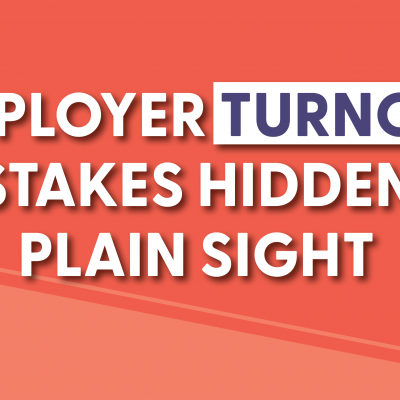Nobody is perfect (sorry, mom). We all make mistakes and (some of us) then try to learn from those mistakes so we don’t repeat them. When it comes to employee turnover, however, there are countless moments in an employee’s lifecycle that could make or break their experience to the point of no return.
There are some obvious reasons why an employee might leave your organization, such as better pay, a new job title, or having disagreements with management. While there is only so much in your control when it comes to helping ensure your organization offers competitive salaries and benefits, provides opportunities for career advancement, and trains managers, there are some other perilous pitfalls that are in your control and are hiding in plain sight.
Here are some scenarios you should be aware of, and what you can do to shore up these gaps in your talent retention strategy.
1. When a poor leave of absence experience has talent headed for the exit
In the dynamic landscape of human resources, managing employee leaves of absence (LOA) is a critical function that directly influences talent retention. A poorly handled LOA experience can inadvertently become the exit ramp for valuable employees, sending them hurtling toward the job boards.
As an HR leader within your organization, it’s imperative to recognize the profound impact that mishandling leave situations can have on employee engagement, morale, and ultimately, organizational stability.
When an employee faces a challenging period, whether due to health issues, personal reasons, or unforeseen circumstances, the manner in which their leave is managed can either fortify their connection to the company or sever it altogether. A lack of communication, insensitive handling, or bureaucratic roadblocks during the LOA process can leave employees feeling undervalued and disengaged.
The repercussions can extend beyond the absence itself and their effects often resonate in the post-leave period. Talented individuals who endure a negative LOA experience may harbor lingering discontent, fostering a toxic work environment that erodes team cohesion.
As HR professionals, it’s crucial to view each LOA as an opportunity to showcase the organization’s commitment to employee well-being.
If your processes are currently confusing, manual, and frustrating for all parties involved, perhaps look into dedicated leave management software that prioritizes empathy, clear communication, and streamlined processes. This puts you in a position to not only retain your talent but also bolster your reputation as an employer of choice.
It’s not insignificant that a poor leave of absence experience is a leading indicator of the following turnover pitfalls as well.
2. When work-life balance looks good on paper but not in practice
Nothing is more disenfranchising to an employee than when an employer makes a promise they can’t deliver on. Here are some examples of this that are playing out today:
- Offering a remote work option only to then require employees to return to office life.
- Having fantastic leave policies but making it a nightmare to actually take a leave of absence
- Providing amenities in the office for employees to take breaks and enjoy, but having a culture that doesn’t encourage their use.
“Work-life balance” can’t just live as words in a job description. It needs to be encouraged and reinforced as an integral fiber of your company culture. Employees can tell when work-life balance is just buzzword lip service and when their employer really means it.
Despite your best efforts to foster an empathetic and supportive company culture, again there is much that occurs beyond your control. So identify the areas you can control and implement processes and systems that remedy the situation.
This is another example of where leave management software can make all the difference. Not only does it make your life easier administratively, it also gives employees the belief that their employer truly cares about work-life balance and not only walks the walk but talks the talk.
3. When ineffective workforce management causes burnout
Ineffective workforce management can be a breeding ground for burnout, jeopardizing both employee well-being and organizational productivity. When people leaders fail to allocate resources efficiently, overburdening individuals or neglecting workload distribution, it leads to increased stress and fatigue.
The absence of clear communication (more on that shortly), inadequate training, and insufficient support exacerbate the problem. Employee exhaustion and reduced production efficacy become inevitable when workforce planning isn’t prioritized, which in turn results in high turnover rates and decreased job satisfaction. This begets continued high turnover rates and decreased job satisfaction, which begets…well you get the picture.
The ripple effect is felt in a variety of ways detrimental to organizational success, from compromised team dynamics to compromised quality of work and client dissatisfaction.
Proactive, collaborative workforce management, on the other hand, gives management the power to establish balanced workloads, open communication, and skill development, all of which are crucial to mitigate burnout and foster a resilient (and retainable) workforce.
This is another opportunity to leverage the powerful capabilities of leave-of-absence software. A more modern solution to LOA management creates a holistic window into workforce planning for HR leaders and people leaders alike, leading to better planning, better productivity, and happier employees.
4. When unclear communication leads to workplace breakdowns
Just like in every other avenue of life, unclear communication serves as a potent catalyst for relationship breakdowns in the workplace, fostering misunderstandings and eroding trust. When messages lack clarity or intention, confusion festers and assumptions arise, creating a workplace environment ripe for conflict.
Misinterpretations, unmet expectations, and unresolved grievances may accumulate over time, poisoning the foundation of relationships which of course can lead to an uptick in turnover.
The absence of transparent dialogue amplifies feelings of frustration and isolation, escalating minor issues into insurmountable challenges.
The impact of communication breakdowns can vary wildly depending on what exactly is being poorly communicated. Failing to communicate an employee’s promotion might not have the same negative impact as failing to inform an employee of the steps they need to take when applying for state benefits on their leave of absence journey.
Small communication mishaps are an inevitable part of running a business. We all try our best but as we mentioned up top, nobody is perfect, and that is especially true when trying to communicate with your peeps during critical moments in their employee lifecycle, such as (you guessed it) when a major life moment happens and they’re relying on you to guide them through the LOA process when they need it most.
5. When the wrong people are hired to fill in the gaps
You can’t bat a thousand when it comes to hiring candidates, but there are external factors that certainly influence your stats. A prime example of one of these influences is when People Ops have pressure to hire someone quickly to fill a gap.
Hiring the wrong individual in this scenario can straight up wreak havoc on employee turnover.
Misaligned skills, values, or work styles (or a sweet concoction of all three…) can contribute to dissatisfaction and employee disengagement. Incompetence or cultural misfit disrupts team cohesion, triggering resentment and frustration within your organization, resulting in a negative environment that may lead to even more turnover as talented employees seek environments where their skills are valued and are supported by an aligned team of individual contributors.
Since the right leave management software can reduce workforce planning blind spots, especially for long-term leaves of absence, empowering your people leaders to properly plan and fill in gaps as needed, removing the pressure on you to deliver new hires faster than you can properly vet them.
Transforming Turnover Mistakes Into Retention Wins
The cost of recruitment, onboarding, and lost productivity compounds the financial and administrative toll of employee turnover. Your employee’s leave of absence experience can act as your canary in the coal mine, revealing other turnover pitfalls that may be hidden in plain sight.
Better leaves, an emphasis on living your work-life-balance message, smarter workforce planning, clearer communication, and putting yourself in ap position to hire the right people to fill in gaps can help turn retention rate regression into an undeniable organizational strength leading to happier employees, more productivity, and becoming an attractive landing spot for potential candidates.
About Tilt
Tilt is leading the charge in all things leave of absence management through easy-to-use tech and human touch. Since 2017, our proprietary platform and Empathy Warriors have been helping customers make leave not suck by eliminating administrative burdens, keeping companies compliant, and providing a truly positive and supportive leave of absence experience for their people.







